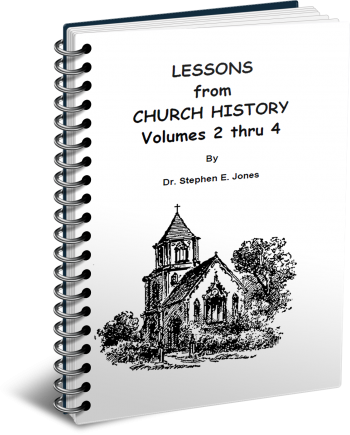Latest Posts
View the latest posts in an easy-to-read list format, with filtering options.

Volumes 2-4. This is the history of the Church from the Roman War (66-73 A.D.) to Constantine and the Council of Nicea in 325 A.D. with lessons to be learned from it.
Category - History and Prophecy

Titus, the Roman general who destroyed Jerusalem in 70 A.D., did not intend to destroy the temple, but in the ravages of war, things do not always go as planned. Fire broke out and became impossible to quench because of the situation. The fire became so intense that the gold melted between the stones, and the soldiers then retrieved the gold by not leaving one stone upon another. So Jesus' prophecy was fulfilled, as recorded in Matt. 24:1, 2,
{Matthew 24:1} 1 And Jesus came out from the temple and was going away when His disciples came up to point out the temple buildings to Him. {Matthew 24:2} 2 And He answered and said to them, “Do you not see all these things? Truly I say to you, not one stone here shall be left upon another, which will not be torn down.”
Jesus and His disciples were probably viewing the temple from the Mount of Olives on the east side, which provided a tremendous panoramic view above the temple and its courts. This prophecy came immediately after Matt. 23:28-39, in which Jesus lamented over the city for killing the prophets. Verse 38 says, “Behold, your house is being left to you desolate!”
Jesus later said in Matt. 24:15, 16,
{Matthew 24:15} 15 Therefore when you see the abomination of desolation which was spoken of through Daniel, the prophet, standing in the holy place (let the reader understand), {Matthew 24:16} 16 then let those who are in Judea flee to the mountains.
Jesus was referencing Daniel 12:11. It seems obvious that “the abomination of desolation” is associated with the desolation of Jerusalem and especially the temple in 70 A.D. But this does not necessarily exclude a secondary fulfillment later. Many prophecies come to pass more than once, especially if there are aspects of the prophecy that remain unfulfilled the first time around.
For example, Jeremiah 19:10 and 11 prophesies of the utter destruction of Jerusalem in such a way that it could never be rebuilt again. In his day, the city was indeed destroyed and the people taken into captivity to Babylon. However, after 70 years, the people were allowed to return and to rebuild the city under Zerubbabel and Ezra. Some decades later, Nehemiah was commissioned to rebuild the walls of Jerusalem. And so either Jeremiah’s prophecy failed, or it would find another fulfillment in the future.
The city was destroyed again in 70 A.D., but it was rebuilt later. It has been destroyed many times, but has always been rebuilt. Thus, if we believe the words of Jeremiah to be true, we must conclude that there is yet another and more complete fulfillment of Jer. 19:10, 11 in the future.
So also it is with the “abomination of desolation.”
The Jerusalem Church remembered the words of Jesus and did leave Judea before the destruction of the city, for Eusebius says that they moved across the Jordan River to the town of Pella in the country of Perea (modern Jordan). But most of the people did not believe Jesus' words, and certainly their priestly leaders would not have told the people of Jesus’ warnings.
The idea of temple desolation had first occurred in the days of Daniel himself, when the temple was destroyed by the Babylonians in 586 B.C. But technically speaking, this desolation occurred 11 years earlier in 597 B.C. when King Jehoiachin of Judah was replaced by Zedekiah. At that time, the Babylonians emptied the temple of its most valuable sacred vessels, for we read in 2 Kings 24:12, 13,
{2 Kings 24:12} 12 …So the king of Babylon took him [Jehoiachin] captive in the eighth year of his reign. {2 Kings 24:13} 13 And he carried out from there all the treasures of the house of the Lord, and the treasures of the king’s house, and cut in pieces all the vessels of gold which Solomon king of Israel had made in the temple of the Lord, just as the Lord had said.
In 597 B.C., then, the temple became “desolate,” that is, empty. Jeremiah, however, hid the Ark of the Covenant, so that it was not taken to Babylon. Yet we see from this that in 597 B.C. the temple became “desolate,” or empty.
Eleven years later, when Babylon destroyed the city and temple, they took the bronze vessels to Babylon, including the two pillars (named Jachin and Boaz) and the “molten sea” (2 Kings 25:16).
Even after the Judeans returned to the land 70 years later and rebuilt the temple, the original vessels were returned to them, but the Ark was still missing. And so the second temple's Most Holy Place remained desolate, or empty throughout its history.
For this reason, when the Roman general Pompey conquered Syria and Judea in 63 B.C. to begin the “iron” phase of Daniel's prophecy, he went into the temple seeking treasure, but found only an empty room in the Most Holy Place. Josephus tells us the story in Antiquities of the Jews, XIV, iv, 4,
“. . . and no small enormities were committed about the temple itself, which, in former ages, had been inaccessible, and seen by none; for Pompey went into it, and not a few of those that were with him also, and saw all that which was unlawful for any other men to see, but only for the high priests. There were in that temple the golden table, the holy candlestick, and the pouring vessels, and a great quantity of spices; and besides these there were among the treasures two thousand talents of sacred money; yet did Pompey touch nothing of all this on account of his regard to religion . . . . and he made Jerusalem tributary to the Romans. . . and put them under the government of the Roman president, and confined the whole nation, which had elevated itself so high before, within its own bounds.”
Notice that there is no mention of Pompey seeing the Ark of the Covenant. Other sources tell us that a stone was placed in the position of the Most Holy Place to mark the location of the original Ark of the Covenant. One wonders how the high priest observed the Day of Atonement each year without a mercy seat on which to sprinkle the blood of the goat. Did he sprinkle it on the stone? We are not told, for no one seems to have recorded this. Perhaps it was too embarrassing.
When the Romans destroyed the second temple in 70 A.D., they took the vessels of the temple to Rome, even as the Babylonians had done in 597 B.C. This is apparent from the Arch of Titus, on which is pictured the Golden Candlestick and the silver trumpets, but no Ark. (See http://sights.seindal.dk/sight/179_Arch_of_Titus.html.)
After each war in which the Romans conquered their enemies, they always held a “Triumph” in Rome. This was a parade headed by the conquering general, leading captives, particularly the enemy leaders. Afterward, they normally killed the captives and dumped their bodies in the Tiber River. The Arch of Titus was built by Domitian, his brother, who succeeded him as Roman Emperor in 81.
The 666 intervening years between these two captivities of the vessels tell us something about the meaning of the well-known number 666. (Note: from 597 B.C. to 70 A.D. is 666 years.) It is not merely the number of “man” or “beast” (Rev. 13:18). It has to do with man taking authority over the Church and its worship, creating a “beast system.” When the Holy Spirit's authority is usurped by men, it is a “666” situation. Taking the holy vessels captive is prophetic of usurping authority over the holy things of God. The Holy Spirit is to lead the worship in the Church, but when men usurp that authority, it is “666.”
It is also an abomination of desolation, because the Holy Spirit is replaced by “an evil spirit from God,” as in the days of King Saul (1 Sam. 18:10). The evil spirit substitution is an abomination.
When the evil spirit from God came upon Saul, he continued to prophesy, thinking that it was by the Spirit of God, not knowing the difference between the Holy Spirit and the evil spirit from God. This evil spirit is mentioned seven times in connection with Saul (1 Sam. 16:14, 15, 16, 23 (twice); 18:10; and 19:9). Because King Saul was crowned on Pentecost (the day of wheat harvest—1 Sam. 12:17), King Saul was a type of the Church in the Pentecostal Age.
This “evil spirit from God” is part of the prophecy of the condition of the Church during the Pentecostal Age. For this reason, it is evident that the Holy Spirit's presence decreased continually after the first century, leading some to believe that this was “normal,” or that the gifts of the Spirit were only for the apostles but ceased after the death of John. Perhaps they did cease, but what kind of spirit replaced the Holy Spirit?
That too is part of Church history. If this had not been prophesied in the Old Testament in the life of King Saul, one might question whether or not one should be a Christian, considering the often sordid history of the Church in its later years.